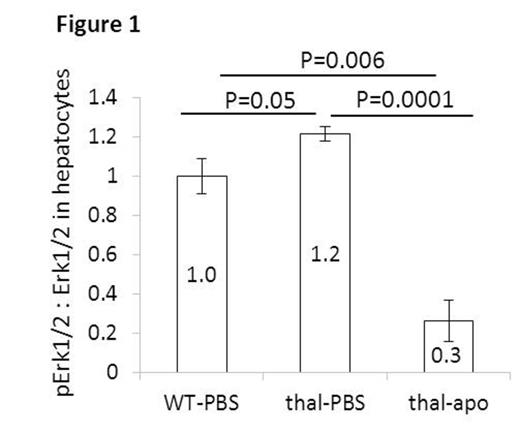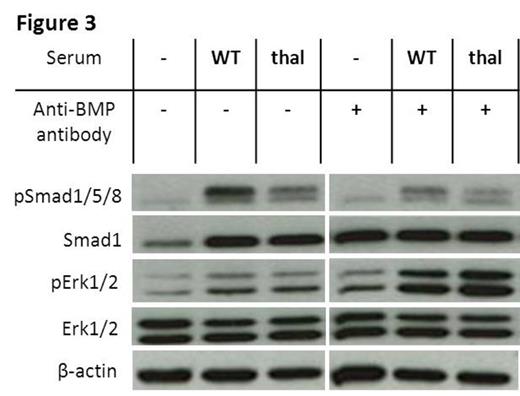Abstract
Iron overload causes morbidity and mortality in patients with β-thalassemia. Transfusion independent patients develop iron overload from increased dietary iron absorption, implicating inappropriately low hepcidin and supporting the therapeutic potential of approaches to increase hepcidin. Relatively low liver hepcidin mRNA expression is also characteristic of mouse models of β-thalassemia, and a recently identified erythroid factor, erythroferrone, has been implicated in hepcidin suppression in thalassemia. We have previously shown that exogenous apo-transferrin injections result in relatively iron restricted erythropoiesis, ameliorate ineffective erythropoiesis, and increase hepcidin expression in Hbbth1/th1 β-thalassemia intermedia (thalassemic) mice. We now explore the effect of exogenous apo-transferrin on signaling pathways (i.e. Smad and Erk) and circulating parameters thought to participate in hepcidin regulation in vivo and in vitro in wild type (WT) and thalassemic mice. Our results demonstrate that apo-transferrin injection increase both serum hepcidin concentration (603 vs. 306 ng/ml, n=13-24 per group, P<0.0001) and liver mRNA expression (2.3-fold, n=8-12 per group, P=0.003) despite decreased circulating serum iron (96 vs. 180 μg/ml, n=6-8 per group, P=0.001) and parenchymal liver iron (1.0 vs. 1.3 µg/mg, n=10-12 per group, P=0.04) concentrations. Increased hepcidin in apo-transferrin treated thalassemic mice is unrelated to changes in liver Bmp6 mRNA expression (1.1-fold increase, n=8 per group, P=0.49) but correlates well with serum BMP2 concentration (1.3-fold increase, n=6-9 per group, P=0.03). Freshly isolated hepatocytes from thalassemic mice exhibit more pErk1/2 and a higher ratio of pErk1/2:Erk1/2 relative to WT mice, and apo-transferrin treated thalassemic mice exhibit a significant suppression of the Erk1/2 pathway (Figure 1 ) and increased Smad activation (1.4-fold increase, n=4-6 per group, P=0.02). These findings strongly suggest an inhibitory effect of the Erk pathway on hepcidin expression. We thus evaluate the effect of Erk inhibitor U0126 on freshly isolated hepatocytes from WT mice and demonstrate that erk inhibition in vitro also results in a dose-dependent increase in hepcidin expression (3.7-fold increase at 50µM U0126, P=0.0003) with no change in Smad1/5/8 phosphorylation. To further evaluate the role of circulating factors on the regulation of hepcidin expression with apo-transferrin treatment, we analyzed the effect of serum from PBS- and apo-transferrin treated WT and thalassemic mice on cultured primary hepatocytes from WT mice. A significant increase in hepcidin expression is observed in cells exposed to serum relative to untreated cells (Figure 2 ), while hepatocytes treated with serum from thalassemic mice demonstrate suppressed hepcidin expression and pSmad1/5/8 relative to WT serum (Figure 2 and 3). Furthermore, primary hepatocytes concurrently treated with serum and neutralizing anti-BMP2/4 antibodies have relatively suppressed hepcidin expression in each condition relative to cells treated with serum alone (Figure 2 ), suggesting again the importance of BMP2 in hepcidin expression. The treatment with serum and neutralizing anti-BMP2/4 antibodies also suppressed Smad1/5/8 and induces Erk1/2 pathway activation (Figure 3 ). Lastly, erythroferrone expression is increased in sorted orthochromatophilic bone marrow erythroblasts in thalassemic relative to WT mice and normalized by apo-transferrin injection in thalassemic mice (2.4-fold increase thalassemic vs. WT mice (P=0.008); 2-fold decrease apoTf-treated vs. PBS-treated thalassemic mice (P=0.03)). No differences are observed either in GDF15 or TWSG1 in sorted bone marrow orthochromatophilic erythroblasts. These findings support the importance of erythroferrone as an erythroid regulator in thalassemic mice, suggest that the effect in Hbbth1/th1 mice and Hbbth3/+ mice are comparable, and provides further evidence that treatment with apo-transferrin reverses ineffective erythropoiesis in thalassemic mice. In total, our findings support a model in which treatment of Hbbth1/th1 mice with apo-transferrin decreases bone marrow erythroferrone expression, decreases hepatocellular Erk activation, and increases Smad activation to increase liver hepcidin expression.
Westerman:Intrinsic Lifesciences LTD: Employment, Equity Ownership.
Author notes
Asterisk with author names denotes non-ASH members.




This feature is available to Subscribers Only
Sign In or Create an Account Close Modal